Baldwin I of Jerusalem facts for kids
Quick facts for kids Baldwin I |
|
|---|---|

Baldwin's coronation, as illustrated in a 13th-century text (Bibliothèque nationale de France)
|
|
| King of Jerusalem | |
| Reign | 1100–1118 |
| Coronation | 25 December 1100 |
| Predecessor | Godfrey of Bouillon (as Defender of the Holy Sepulchre) |
| Successor | Baldwin II |
| Count of Edessa | |
| Reign | 1098–1100 |
| Successor | Baldwin II |
| Born | c. 1060 |
| Died | 2 April 1118 Al-Arish, Fatimid Caliphate |
| Burial | Church of the Holy Sepulchre, Jerusalem |
| Spouse |
|
| House | House of Flanders |
| Father | Eustace II of Boulogne |
| Mother | Ida of Lorraine |
Baldwin I, also known as Baldwin of Boulogne, was a key leader during the First Crusade. Born around 1060, he became the first Count of Edessa from 1098 to 1100. Later, he was crowned the first King of Jerusalem, ruling from 1100 until his death in 1118. He was the youngest son of Eustace II, Count of Boulogne, and Ida of Lorraine.
Baldwin joined the crusader army led by his brother, Godfrey of Bouillon. He became one of the most successful commanders of the First Crusade. He helped establish the first Crusader state in Edessa. After his brother Godfrey died, Baldwin was chosen to rule Jerusalem. He expanded the new kingdom, capturing important coastal cities with help from Italian fleets. He also defended the kingdom against attacks from Egypt and Syria. Baldwin was seen as the main leader of the crusader states in the Middle East. He died during a military campaign in Egypt.
Contents
Early Life and Crusader Journey
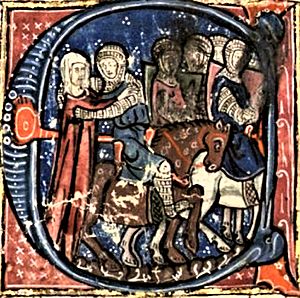
Baldwin was born around 1060. He was the third son of Eustace II, Count of Boulogne, and Ida of Lorraine. As the youngest son, he was first meant to have a career in the Church. He studied and held positions in important cathedrals. However, at some point, he decided to become a knight instead. Historians believe he might have wanted a more active life or saw a chance to gain power.
Baldwin married Godehilde of Tosny, a noblewoman from Normandy. Her family owned land in both Normandy and England. Baldwin and Godehilde likely lived at the court of his oldest brother, Eustace III of Boulogne. Baldwin often helped his brother Godfrey, showing he was seen as a possible heir.
Joining the First Crusade
Pope Urban II called for the First Crusade in November 1095. Baldwin's brother, Godfrey of Bouillon, decided to join. Godfrey sold or mortgaged his lands to raise money for the journey. Baldwin also joined the crusade. His wife and children came with him, suggesting he planned to stay in the East.
The crusaders traveled through Hungary and then entered the Byzantine Empire. In December 1096, they reached Constantinople. The Byzantine Emperor, Alexios I Komnenos, wanted the crusader leaders to promise loyalty to him. Baldwin even raided areas outside the city walls to get the emperor to cooperate. Eventually, the crusader leaders, including Baldwin, swore loyalty to Alexios. They promised to return any lands they conquered from the Seljuk Turks that had once belonged to the Byzantine Empire.
Campaigns in Cilicia and Edessa
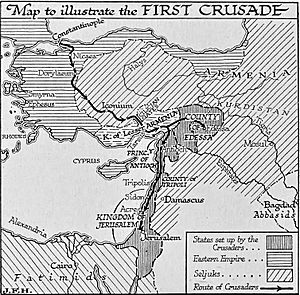
After a major battle in July 1097, Baldwin and another crusader leader, Tancred, separated from the main army. They marched towards Cilicia, a fertile region. They hoped to find food and support from the local Armenians.
Baldwin and Tancred led separate groups. Tancred reached Tarsus first. Baldwin arrived the next day. There was a conflict between their soldiers over who would control the town. Baldwin ended up taking Tarsus. Later, they met again at Mamistra, where another fight broke out between their men. After some conflict, Baldwin and Tancred made peace.
Baldwin then moved towards the Euphrates River, a region with many Armenians. The Armenians welcomed him as a liberator. He captured two important fortresses, Ravendel and Turbessel, without a fight.
Count of Edessa
Establishing the First Crusader State
The Armenian ruler of Edessa, Thoros, asked Baldwin for help against the nearby Seljuk Turks. Edessa was an important Christian town. Baldwin arrived in Edessa in February 1098. Thoros adopted Baldwin, which was a local custom.
Thoros was not popular with all his subjects because of his religious beliefs. Soon after Baldwin's arrival, a riot started against Thoros. Thoros and his wife were killed. On March 10, 1098, the people of Edessa accepted Baldwin as their ruler. He took the title of Count of Edessa, creating the first Crusader state.
Baldwin's control of Edessa was important for the main crusader army. Edessa provided food supplies during the siege of Antioch. It also helped block the movement of Seljuk troops towards Syria.
To strengthen his rule, Baldwin married the daughter of an Armenian lord, named Arda. He also encouraged his knights to marry local women. Baldwin used the wealth he found in Edessa to hire soldiers and buy more land.
Defending Edessa
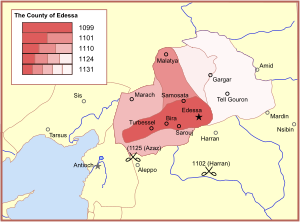
Baldwin faced challenges in Edessa. He collected high taxes, which made some people unhappy. Some Armenian leaders even plotted against him, but Baldwin discovered their plan and arrested them. He continued to appoint Armenian noblemen to important positions.
Kerbogha, a powerful Muslim leader from Mosul, gathered a large army to attack the crusaders at Antioch. On his way, Kerbogha tried to capture Edessa in May 1098. Baldwin defended Edessa for three weeks. This delay prevented Kerbogha from reaching Antioch before the crusaders captured it.
In July 1099, the main crusader army captured Jerusalem. Godfrey of Bouillon was chosen as its ruler. Baldwin traveled to Jerusalem for a pilgrimage. He returned to Edessa in February 1100.
King of Jerusalem
Becoming King
Godfrey of Bouillon died suddenly in July 1100. His supporters in Jerusalem wanted Baldwin to take over. They sent a message urging him to come to Jerusalem.
Baldwin quickly prepared for his journey. He appointed his relative, Baldwin of Le Bourcq, as his successor in Edessa. With about 200 knights, Baldwin left Edessa in October 1100. He faced some attacks on his way but managed to defeat them.
Baldwin arrived in Jerusalem around November 9. He was welcomed by the people. He was crowned king in the Church of the Nativity in Bethlehem on Christmas Day. From then on, he was known as the King of Jerusalem. He often emphasized that he was Godfrey's rightful heir.
Early Victories and Challenges
Baldwin quickly began to expand his new kingdom. He made an alliance with a Genoese fleet. They worked together to capture coastal towns still held by the Egyptians.
In April 1101, they attacked Arsuf, which surrendered easily. Then, they captured Caesarea in May. Baldwin's soldiers took many riches from Caesarea. The Genoese received a share of the loot.
Baldwin also faced challenges from within the crusader leadership. He had disagreements with the Latin Patriarch, Daimbert, over money and power. Baldwin managed to get Daimbert temporarily suspended from his position.
Battles at Ramla
The Egyptians, led by their vizier Al-Afdal Shahanshah, began to send armies to attack the Kingdom of Jerusalem. Baldwin fortified Ramla to protect Jerusalem.
In September 1101, Baldwin's smaller but experienced army fought the Egyptians near Ramla. Despite heavy losses, Baldwin led his remaining troops to a surprise victory. The Egyptians fled in panic.
In May 1102, a stronger Egyptian army invaded. Baldwin and his men were forced to retreat to Ramla. Baldwin managed to escape, but many of his soldiers were killed or captured. He was rescued by an English pirate and returned to Jaffa. The arrival of a large fleet of European pilgrims helped force the Egyptians to lift their siege of Jaffa.
In April 1104, Baldwin, with the help of Genoese and Pisan ships, besieged Acre. Acre was an important port city. It surrendered in May, and Baldwin granted a part of the town to the Genoese. Acre's port brought in a lot of money for the kingdom.
In August 1105, a large Egyptian and Syrian army invaded. Baldwin gathered the biggest crusader army since he became king. They won a decisive victory at Ramla in August 1105. After this, the Egyptians launched no more major campaigns against Jerusalem for a while.
Expanding the Kingdom
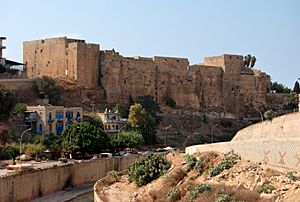
Baldwin continued to expand his kingdom. He helped Bertrand, Count of Toulouse, capture Tripoli in 1109. As the only crowned king in the crusader states, Baldwin claimed to be the overall leader. Other crusader rulers, like Baldwin II of Edessa and Bertrand, swore loyalty to him. Even Tancred, who ruled Antioch, obeyed Baldwin's calls for help.
Baldwin supported Baldwin II and Tancred against a Muslim leader named Mawdud, who attacked Edessa and Antioch. Baldwin built fortresses in Oultrejordain (the land east of the Jordan River). These forts helped him control important trade routes between Syria and Egypt.
In May 1110, Baldwin captured Beirut with the help of Bertrand and a Genoese fleet. He was unable to stop his soldiers from harming the townspeople. Later that year, he besieged Sidon with the help of King Sigurd I of Norway and a Venetian fleet. Sidon surrendered in December 1110.
In 1111, Baldwin tried to capture Tyre, but he did not have a strong enough navy. He was forced to end the siege in April 1112.
Later Campaigns
In 1113, Baldwin faced new attacks from Muslim forces. He was defeated in a battle and had to ask for help from the rulers of Tripoli and Antioch. Later, Baldwin made an alliance with a Muslim ruler, Toghtekin, to fight against a common enemy. This showed Baldwin's clever political skills.
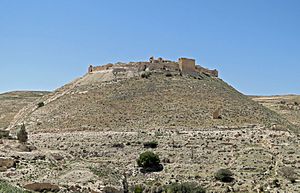
Baldwin continued to strengthen his kingdom's defenses. In 1115, he ordered the building of Montreal Castle in Oultrejordain. The next year, he marched to Aqaba on the Red Sea and built more castles there. These fortresses helped him control trade routes and watch Egyptian movements. He also built Scandelion Castle near Tyre to block the city from the land.
Death and Legacy
Baldwin became very ill in late 1116 but recovered. In March 1118, he launched a campaign against Egypt. He captured Farama on the Nile Delta. However, an old wound from 1103 reopened, and he became very sick.
Baldwin died on April 2, 1118, near Al-Arish. On his deathbed, he named his brother Eustace III as his successor. However, he also allowed his nobles to choose Baldwin II of Edessa if Eustace did not accept the crown. Baldwin I was buried in the Church of the Holy Sepulchre in Jerusalem, next to his brother Godfrey.
Historians describe Baldwin as a skilled military leader and a smart politician. He is credited with building a strong and stable Kingdom of Jerusalem with clear borders. Many believe he was the main person responsible for the crusaders' success in the Holy Land. His ability to work with different groups and adapt to the local situation helped him greatly.
The Bardawil lagoons in Egypt are named after Baldwin, as he died nearby.
Family
| Ancestors of Baldwin I | |||||||||||||||||||||||||||||||||||||||||||||||||||||||||||||||||||||||||||||||||||||||||||||||||||||||||||||||||||||||||||||||||||||||||||||||||||||||||||||||||||||||||||||||||||||||||||||||||||||||||||||||||||||||||||||||||||||||||||||||||||||||||||||||||||||||||
|---|---|---|---|---|---|---|---|---|---|---|---|---|---|---|---|---|---|---|---|---|---|---|---|---|---|---|---|---|---|---|---|---|---|---|---|---|---|---|---|---|---|---|---|---|---|---|---|---|---|---|---|---|---|---|---|---|---|---|---|---|---|---|---|---|---|---|---|---|---|---|---|---|---|---|---|---|---|---|---|---|---|---|---|---|---|---|---|---|---|---|---|---|---|---|---|---|---|---|---|---|---|---|---|---|---|---|---|---|---|---|---|---|---|---|---|---|---|---|---|---|---|---|---|---|---|---|---|---|---|---|---|---|---|---|---|---|---|---|---|---|---|---|---|---|---|---|---|---|---|---|---|---|---|---|---|---|---|---|---|---|---|---|---|---|---|---|---|---|---|---|---|---|---|---|---|---|---|---|---|---|---|---|---|---|---|---|---|---|---|---|---|---|---|---|---|---|---|---|---|---|---|---|---|---|---|---|---|---|---|---|---|---|---|---|---|---|---|---|---|---|---|---|---|---|---|---|---|---|---|---|---|---|---|---|---|---|---|---|---|---|---|---|---|---|---|---|---|---|---|---|---|---|---|---|---|---|---|---|---|---|---|---|---|---|---|
|
|||||||||||||||||||||||||||||||||||||||||||||||||||||||||||||||||||||||||||||||||||||||||||||||||||||||||||||||||||||||||||||||||||||||||||||||||||||||||||||||||||||||||||||||||||||||||||||||||||||||||||||||||||||||||||||||||||||||||||||||||||||||||||||||||||||||||
Baldwin's first wife, Godehilde of Tosny, died during the First Crusade in 1097. Some historians believe her death might have made Baldwin decide to seek a new lordship in the East. It is not clear if Baldwin had any children.
His second wife was an Armenian ruler's daughter, often called Arda. They married in 1098. Her father promised a large dowry, but only paid a small part. They had no children. Baldwin later sent her to a convent in Jerusalem.
Baldwin's third wife was Adelaide, a wealthy widow from Sicily. They married in 1113. Baldwin was interested in her wealth. This marriage was complicated because his second wife, Arda, was still alive. After a serious illness, Baldwin sent Adelaide back to Sicily in 1117. This upset her son, Roger II of Sicily, who then refused to help the Kingdom of Jerusalem.
See also
 In Spanish: Balduino I de Jerusalén para niños
In Spanish: Balduino I de Jerusalén para niños





